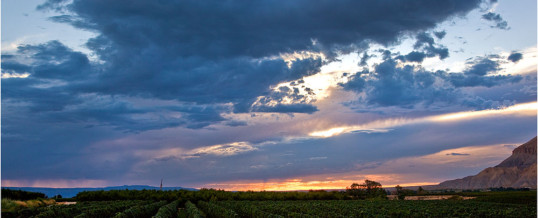
From the GJ Daily Sentinel
By Tamera Minnick
Soils are vital to ecosystem health. In the U.S., we learned this the hard way in the 1930s Dust Bowl. Extreme drought was just one of the drivers of the Dust Bowl. The effects were magnified by economic, policy and land management decisions during the prior decade.
At the end of World War I, European agriculture was in disarray and American agriculture benefited. During a few years, wheat prices were high and borrowing money was easy. The result was 5.2 million acres of marginal agricultural lands plowed to grow wheat. In retrospect, we now appreciate that these lands should have stayed as native grass.
Once that soil was destabilized by plowing and left bare in the drought, it blew. And blew. People died of dust pneumonia — not caused by a bacteria or virus, but from the dust itself.
In 1935, Dr. Hugh Bennett, a soil scientist, prescribed protecting and revegetating these marginal lands with grasses. When government agencies insisted that soil was a resource that could not be exhausted, Bennett replied, “I didn’t know so much costly misinformation could be put into a single brief sentence.” The main problem with Bennett’s ideas, like today, was that he had to persuade Congress to fund them.
Congress was stubborn, but Bennett rescheduled a hearing for an afternoon in which he knew that a big duster had formed and was headed for Washington, DC.
As the meeting began, success appeared unlikely. It suddenly grew dark. The dust storm blew in and turned day to night. Funding was approved. This was the inception of what would become the Soil Conservation Service, now the Natural Resources Conservation Service. Today, most farmers have easy access to an NRCS office.
NRCS strives to decrease erosion by aiding farmers in adopting techniques such as low- or no-till plowing, contouring with the landscape, using buffer strips around water, and planting shelterbelts.
Building on this success, President Ronald Reagan implemented the Conservation Reserve Program in 1985. The intent was to take marginal land, mostly land at risk for erosion, out of crop production and plant native grass. The federal government pays rent to farmers for providing this public service of stabilizing these marginal lands.
The CRP has decreased erosion, improved wildlife habitat, and enhanced water and air quality, all while keeping the land in private ownership.
One of the deficiencies of the CRP is the short-term nature of the contracts. For 15 or 20 years, erosion is controlled, soil organic matter gradually accumulates, wildlife populations rebound, and sites stabilize. But there can be sudden changes.
For instance, in 2007, crop prices increased dramatically. Many marginal lands were put back into crop production. In one year, many of those public goods, paid for by taxpayers, were eliminated.
In the late 1990s, a new conservation tool was developed — conservation easements. With conservation easements, the right to develop the land is relinquished and, in return, the owner usually is accorded significant tax credits.
One similarity between the CRP and conservation easements is that entering into either one is voluntary. The landowner makes a personal and economic decision that the program is the right thing to do with his or her private land. Additionally, the private land remains private.
There are some major differences between conservation easements and CRP. Under conservation easements, many land uses are allowed, including continued crop production; these are described in a contract. Also, the easement is often held by a non-profit (like our own Mesa Land Trust). The result of an easement is a substantial tax credit (which in Colorado can be transferred to others). Finally, the easement is permanent, not just a 10- or 15-year contract.
That last point is important. At Colorado Mesa University, my colleagues, students, and I have reported that it may take our fragile western soils 50 years or more to recover to a healthy functioning status following damage (and much longer if topsoil is lost to erosion). Permanent conservation easements assure public investments will not be lost with short-term fluctuations in commodity prices.
Another reason that conservation easements are in perpetuity? In order to gain the federal and Colorado tax credits, the easement must be permanent.
Mesa Land Trust is phenomenally successful in our county. There is widespread support, and they have helped landowners protect, in perpetuity, over 66,000 acres. Much of this is important wildlife habitat outside of the valley, while some insures that agriculture thrives in the valley and that we have buffers between our towns to preserve the rural character of our area.
Conservation easements are a modern tool based on our improved understanding of the science of how ecosystems function. Their perpetual nature guarantees the public’s return on this investment.
Tamera Minnick, Ph.D., is a professor of environmental science and technology at Colorado Mesa University where she has taught soil science and sustainability. She recently renewed her membership with Mesa Land Trust. Much of the Dust bowl information came from Timothy Egan’s “Worst Hard Time: The Untold Story of Those Who Survived the Great American Dust Bowl.” Email tminnick.gjsentinel@yahoo.com.
ShareJUL
2017
